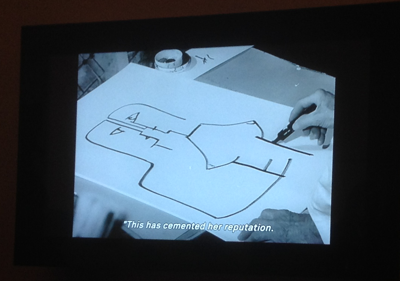
‘Never keep both feet on the ground’, Hannah Hoch
A large retrospective of the collage work of Hannah Hoch has just opened at the Whitechapel Gallery. Not a household name in the UK, she was an influential German artist who lived from 1889 to 1978. Curated by Daniel Herrmann and newly CBE-ed Professor Dawn Ades, this is the first major exhibition in London devoted to this female Dadaist and pioneer of collage. It fills the main galleries with over 125 wall-based pieces that rarely travel abroad.
Hoch was active in many types of media, but this show focuses on her collage work, showing her as a leader, a Dadaist and one of the earliest proponents of the technique. She was a Photoshop user before there was such a thing and you get the feeling she would have loved to play with the electronic image manipulation that is possible today. Her first collage piece sees her cutting up and repositioning her own deftly worked patterns, concentrating on aesthetics rather than the politics of her later works. She worked in the fashion publishing industry and her early pieces are grounded in the symmetries of embroidery which she believed was ‘an art and ought to be treated like one.’
The exhibition is divided into sections which each focus on a part of Hoch’s artistic output. Arranged chronologically we can see her techniques and interests change and develop from a traditional nude drawing (circa 1912) to her large collage of self-portraits from 1972. Her aim is clearly stated early on – she wished to ‘show that there are millions and millions of other justifiable points of view besides yours and mine,’ and to ‘to blur the firm borders that we human beings, cocksure as we are, are inclined to erect around everything that is accessible to us.’
In collage she had found the ideal methodology. Her collages change viewpoints cubistically, make the small large, add human legs to monkeys and give a sense of the splits of personality within every human. For her a simple portrait could not convey everything she wanted to say. Splitting a man’s head in two and sticking a women in between the two halves helped show his inner life.

Heads of State, Hannah Hoch
Having consumed collages for decades in art and advertising 21st century eyes are inured to the Wow factor that must have greeted her early exhibitions. To me her works are rarely visually exciting, being a long procession of images culled from magazines, cut up and reassembled. It takes more than unexpected juxtapositions to raise a smile today. If you can recognise obscure characters from 1920s and 30s Berlin then you can put names to faces, but my knowledge of such people is – as I expect is that of most viewers – negligible. I can pretty much recognise Hitler (it’s the moustache mainly) and maybe Kaiser Bill (it’s the helmet) but Friedrich Ebert is beyond me. Would you recognise him – even if I said he’s one of the chaps above? The images Hoch has chosen have significance which is lost on the modern audience.
An essay by Professor Dawes in the impressive catalogue quotes a short story Hoch wrote about an artist, which shows the playful side of her creativity that is no longer obvious from the fading images. An artist was unable to recover his equanimity after having been asked – several times – by his wife to wash-up. In fact they’d been married four years and she’d asked four times. He graciously allowed the one request as she was giving birth at the time – but the other three played on his mind until he couldn’t work. Is domesticity the enemy of art?
A scrapbook from 1934 is given a room to itself, along with a wall-sign informing us that it ‘was never originally intended to be exhibited as a work of art.’ This seems a strange admission, as there it is, in a glass case, looking like something of great interest to scholars and art historians but not adding much to the show for visitors.
The final gallery space shows work from her later career. As she ages Hoch develops a good line in titles. We have moved from ‘Embroidery pattern no.3’ to ‘Poetry around a Chimney’. A short film shows her at work on a drawing, the sort of which would have been good to see in the show.

Still from short film about Hoch at the Whitechapel Gallery
Important for her contribution to collage, she relied on scissors and Pritt-stick, but the effects she achieved lie behind the montages and image mashups that are ubiquitous today. This show covers her six decade career and includes wall-texts only recently translated into English. The collages continue relentlessly and become repetitious – if only I’d been consulted I would have advised less collages, more of her work in other media. Alas the phone call never came, but as Hoch is not known in England a general overview of her output would have been helpful. The Whitechapel has put on a very serious attempt to bring one element of Hoch’s work to the British public. The website says that Advance Booking is strongly recommended. I think that’s optimistic, but if you are interested in the early days of collage and photomontage then Aldgate East is where you need to be. Particularly before 23rd March. After that you’ll definitely be disappointed.
Whitechapel Gallery
15 January 2014 – 23 March 2014
Tickets £8.95/£6.95

Leave a Reply